Search results
83 results found.
83 results found.

If someone in Venice were to ask me where I live, the generic answer would be “Castello,” which is the name of the sestiere, or one of the six neighborhoods into which Venice is divided. But that’s just a little too generic, considering that Castello is fairly large and has several hundred little subsets with all sorts of variations ranging from the sublime to the moderately mystifying.
The more precise answer is “Via Garibaldi.” We don’t actually live right there — we’re down beyond the end of it. But it’s an answer which represents not only geographical coordinates and a zip code, but an entire biosphere of its own with its own history and climate and fauna, a zone which to Venetians of other sestieri still connotes verging on the exotic, even vaguely hazardous.
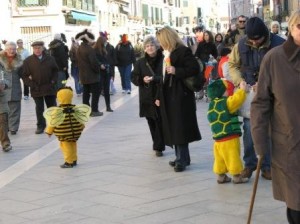
Once, when we were living in Dorsoduro, we overheard a mother snapping at her kid: “Stop shouting! You sound just like somebody from Castello!” And when we moved away — to Castello, of all places — Lino could hardly believe how far down in the world he had come. To his relatives, he might as well have gone to Tasmania. In fact, Tasmania would have made some sense. But Castello?
Many, if not most, people who visit Venice think of the city of palaces and monuments, and maybe also some trendy boutiques and clever little galleries. Our part of Venice is a gristly precinct beyond and behind the Arsenal. The Arsenal was the shipyard where Venice’s fleets were built, the foundation on which Venetian power — economic, military, political — rested. It’s thanks to the Arsenal that all those palaces and monuments exist, so Castello doesn’t have to apologize to anyone if it has chosen to remain in its primordial state. During Venice’s Great Days there were as many as 10,000 people working in the Arsenal, and their dwellings and relatives surrounding it constituted what amounted to a company town. Although very few, if any, locals still work in the Arsenal, I’m convinced there are people here who still haven’t discovered fire.
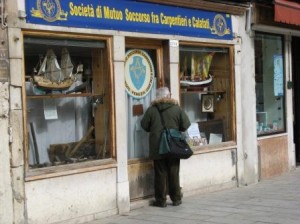
If Venice isn’t a place for everybody, Castello is even less so. And Via Garibaldi is the axis of a Hogarthian world where the men’s bodies swarm with tattoos; where men and women alike use hand-hewn phrases which can’t be translated and shouldn’t be repeated, and their rampant children have two basic ways of communicating: Yelling and crying. They’re a lot like London’s East Enders (denizens of another once-great seaport enclave) — tough, practical, unromantic yet sentimental homebodies to whom family and neighborhood are the universe, where grown men call each other “love” and women call each other “girls.” It’s not that they don’t know there’s a world out there, they just don’t find it all that interesting.
I love Venice in a complicated way that I don’t understand very well. In the midst of the obvious beauty and grandeur and all, the city is also composed of so many aspects which verge on ugliness but which, strangely, also have their own sort of allure. Nelson Algren once wrote that “It isn’t hard to love a town for its greater and lesser towers … but you never truly love it till you can love its alleys too.” You discover this in unexpected moments and glimpses, where she doesn’t mind you seeing her without her girdle: no excuses, no apologies.
The “alleys” would be out here, with the ingenious, illegal, improvised sewer outflows, and the “What, me worry?” deposits of dog poop and the hand-lettered signs vilifying the anonymous neighbor who has left his bag of garbage under your window, and the mismatched lifelong friends in the bar shouting at each other — the one who’s right and the one who’s wrong — about something that happened years ago. In fact, they’re both right. Or wrong.

This is not nostalgie de la boue; many things about life down here in the bilges range from infuriating to only slightly flinch-worthy. Then there are the aspects you can’t easily categorize — say, the septic tank somewhere on the other side of our canal which for far too long desperately needed pumping out. When we had company for dinner I used to pray that the wind wouldn’t shift. They say you can get used to anything, but I’m here to tell you: Not that.
I was walking down the via Garibaldi one early evening; there was a middle-aged Venetian couple coming toward me.
There had been a few airplane crashes that month: One in the sea just outside Palermo, another that hit near Athens, now one in Venezuela somewhere.
Anyway, I reach earshot just as the woman is saying to her husband, “Not me. I’ll never go on an airplane. Forget it.”
He says, “What about a ship?”
“Not even a ship. I’m staying home, I’m not going anywhere. If I die, I’m going to die right here in Via Garibaldi.” (Wait a minute — “If” you die?).
That’s what the true voice of a neighborhood sounds like — especially this one. Via Garibaldi to the bitter end.
I’m with her.
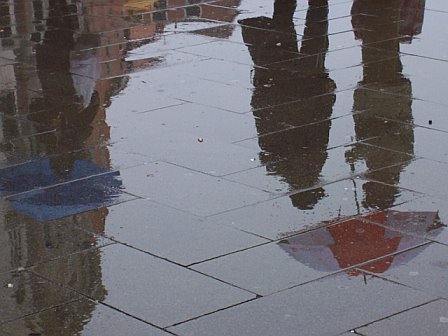
There’s so much to say about tourism in Venice I’ll have to go in easy stages, filling many pages and posts. Let’s start with last weekend, which demonstrated the rough outlines of what the term “tourism” can mean here.
The first of May is a holiday in much of Europe, its version of Labor Day in which we celebrate workers and excoriate employers.
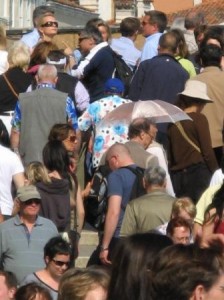
Nothing quite so simple anymore as sending armies and tanks marching across Red Square; this year saw mass demonstrations of angry workers (and ex-workers) in Greece, France, Turkey, Spain, and Germany, and even Russia, which once reveled more in its military parades than rallies of irate trade unions.
Here in Venice, it was just another day in the march of money, and in fact there are plenty of days you could label “mayday mayday,” when holidaying legions of tourists from all over Europe march across the city. So far this year the Horde-Meter has registered Carnival, followed by Easter weekend, then by April 25 (which fell on a weekend this year), and finally May 1.
There were roughly 60,000 tourists per day, instantly doubling the city’s population, shuffling along the narrow streets, overwhelming the Piazza San Marco, and turning the vaporettos (when and if you finally managed to get on one) into something from the Pushkar Camel Fair. Hundreds of tourist coaches unleashed their day-tripping multitudes onto a city whose only public space, the Piazza San Marco, is 320 times smaller than Red Square. Let’s put it another way: The Piazza covers 255 square meters, and crowd-density experts estimate that one square meter can reasonably (we’ll leave some latitude for what that means) hold 3-4 people. That means that ideally there would be no more than 1,000 people in the Piazza at any given time. Let’s say that the crowds peak at noon, and let’s say that that amounts to 40,000 people. Or even 30,000, half the daily total. Or even 20,000, one-third the daily total. Numbers aren’t my strongest point but I think I could already have guessed that there might be as much as 20 times more people in the Piazza than would be pleasant.
The ACTV added three runs per hour to its already heavy Grand Canal vaporetto schedule (reaching a total of 37 extra runs), as well as nine extra runs to Murano and Burano and 13 extra back to Venice. But it’s never enough, in the sense that “enough” would mean no waiting, no crushing, no delays. 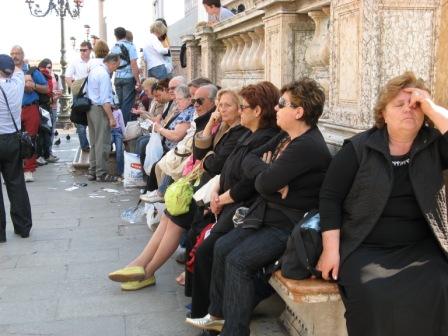 It would be an impressive spiritual exercise for anyone wanting to determine how much compassion they can feel toward their fellow humans to board the #1 local vaporetto line at Piazzale Roma on any Mayday (which amounts to virtually any day from May 1 to September 1) with their soul full of love for humankind, and then measure what’s left by the time they reach San Marco.
It would be an impressive spiritual exercise for anyone wanting to determine how much compassion they can feel toward their fellow humans to board the #1 local vaporetto line at Piazzale Roma on any Mayday (which amounts to virtually any day from May 1 to September 1) with their soul full of love for humankind, and then measure what’s left by the time they reach San Marco.
If you look at tourism in Venice in strictly logistical terms, you can see that it’s a fascinating little problem, which so far has defeated solution. There are approximations of functionality (more vaporettos), but essentially there is no way in which a city which covers only three square miles can prevent or neutralize the stress caused by this particular kind of mass demonstration. It can only be minimized, sort of.
I spent an hour in the Piazza and I came away with one unexpected insight: It’s entirely possible that the gondoliers at the two “stations” (stazi) there were not born crazy. I’ve always wondered about that. I believe it’s likely that they have been made to go crazy by too many days like this. And don’t think all these tourists represent wallets on the hoof. An inverse ratio between quantity and quality has been noticed by almost everyone, something I’ll go into on another occasion.
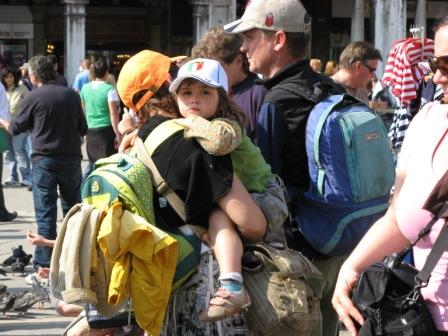 Me, I have no idea how much money you would have to pay me — in cash, even — to go to San Marco on a holiday weekend, at least any later than 7:00 AM. I need to protect what little sanity I have left.
Me, I have no idea how much money you would have to pay me — in cash, even — to go to San Marco on a holiday weekend, at least any later than 7:00 AM. I need to protect what little sanity I have left.
“The contemplation of things as they are, without error or confusion, without substitution or imposture, is in itself a nobler thing than a whole harvest of invention.” (Francis Bacon)
People love to imagine Venice; I think it must be because it’s so strange. You can let your fantasies run riot. But when people ask me, “What’s it like to live in Venice?” with that sort of over-the-rainbow gleam in their eyes, I can’t bring myself to tell them what I think they want to hear. Over-the-rainbow gleams unnerve me. I sense that they are seeking confirmation of their fantasies (which I do not want to know about). Besides, I’ve always thought that the way things are is infinitely more strange and interesting than anything I could ever invent, which is one reason why I’m a journalist and not a novelist.
Of course it’s beautiful, bizarre, fascinating, magical, disturbing, and enchanting. Why else would I be here? But the more time that passes, the more that initial dazzle (I had it too, once) has become alloyed with many more elements, elements that have been known to tarnish and even slightly corrode the old magic. Elements the rainbow people aren’t interested in.
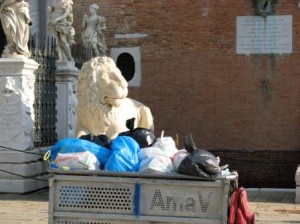 Yet I do think there are people who want to know what it’s really like here, and they’re the ones I’m writing for. So here’s my first answer: “It’s arduous.” It’s hard on everybody, and everybody I know talks about it; whenever the subject of inconvenience, time-and-motion estimates, and general complication of life comes up, Venetians I know are unanimous: “Exhausting.” “Fatiguing.” And so on. It’s demanding physically, mentally, and even emotionally.
Yet I do think there are people who want to know what it’s really like here, and they’re the ones I’m writing for. So here’s my first answer: “It’s arduous.” It’s hard on everybody, and everybody I know talks about it; whenever the subject of inconvenience, time-and-motion estimates, and general complication of life comes up, Venetians I know are unanimous: “Exhausting.” “Fatiguing.” And so on. It’s demanding physically, mentally, and even emotionally.
Physically: You walk miles every day, usually carrying (or lugging) bags that get heavier as your daily Ironman of errands and shopping goes on. I don’t have feet anymore, I have hooves. It’s wearing mentally, as you work to resist the daily dripdripdrip of the self-destructive actions (or non-actions) of the city’s supposed guardians, who instead of laboring for its well-being spend most of their time gnawing on its carcass.
And it’s hard culturally, to endlessly connect and reconnect so many strands of the Venetian universe, past, present, and future. Living in a place which has existed for close to 1,500 years does give you a different perspective in all three of those time frames, it’s true. By this point the Venetian worldview is an intricate tapestry in which pride, even arrogance, and resignation are inextricably entwined.
I’ll tell you right now that I’m not proposing myself as the latest in an endless series of foreigners who has elected herself to make pronouncements about Venice, as if the Venetians were somehow unable to grasp who they are and what their city means.  If you really want to know Venice, even a little bit, you have to meet her on her terms. No shortcuts, no special tricks, because at some point you (by which I mean me) accept that this is a city that was once a nation that ruled an empire stretching, at one time, from Milan to the eastern shore of the Black Sea. The Venetian Republic dominated its world longer than the Roman Empire, longer than the British Empire. Venice has been admired and feared and adored by people who were infinitely more brilliant and talented than I am (by which I also mean you), so it’s a good idea here to just get over yourself.
If you really want to know Venice, even a little bit, you have to meet her on her terms. No shortcuts, no special tricks, because at some point you (by which I mean me) accept that this is a city that was once a nation that ruled an empire stretching, at one time, from Milan to the eastern shore of the Black Sea. The Venetian Republic dominated its world longer than the Roman Empire, longer than the British Empire. Venice has been admired and feared and adored by people who were infinitely more brilliant and talented than I am (by which I also mean you), so it’s a good idea here to just get over yourself.
By this point in history, there can’t be anything really so special about you. Therefore, no matter how much you may love Venice, it will never love you back. It will accept your love, and even appreciate it. But it resists being known by people who are just passing through, and I like that. I respect that.
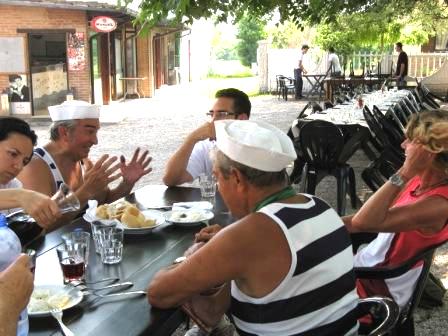
And once you see that, you can begin to find your own place here, and be happy.
What usually jumps to mind when Venice comes up? Undoubtedly something involving water, from “canals” to “flooding” to “sinking.” Some might also throw in “pigeons” and “Carnival.” Beyond that, the general view of Venice from outside is as a vague romantic swath of gondolas in the gloaming and sumptuous palaces that cry out for candles and Casanova. “It seems like a stage set.” I really wish I had fifty cents for every time someone has either said or written that. But it’s true, it does seem like one. I’ve said it myself. Call it a stage set, a cliche’, a dream — in any case, it doesn’t seem real.
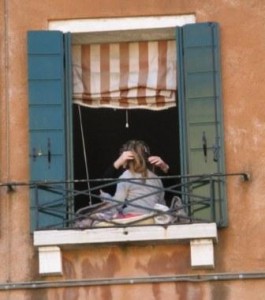 Except that it is. To its diminishing population and beleaguered administrators, Venice is all too real, a classic small town trapped in the body of a fragile and irreplaceable monument, and the millions of tourists passing through each year, some for as little as a few hours, wouldn’t notice that it is in the grip of an apparently unstoppable decline. So much for fantasy. I just heard it fall down dead.
Except that it is. To its diminishing population and beleaguered administrators, Venice is all too real, a classic small town trapped in the body of a fragile and irreplaceable monument, and the millions of tourists passing through each year, some for as little as a few hours, wouldn’t notice that it is in the grip of an apparently unstoppable decline. So much for fantasy. I just heard it fall down dead.
One generation of abuse, neglect, and the wrong kind of love has transformed what it often called the Most Beautiful City in the World into a perpetual line of scrimmage, and to open the daily newspaper, “Il Gazzettino,” is to read a sort of updated scorecard listing penalties, fumbles, Hail-Mary passes, and the number of yards gained or lost in the last encounter, whatever it was. Is anybody winning? Or is everybody just losing at different rates of speed?
So much remains of Venice’s once-legendary grandeur (though less than nothing compared to what it once was) that it’s easy to imagine that it has always been the way you see it today, and that it will remain so. But just as the tide ebbs and flows in the surrounding lagoon, Venice too is constantly changing. Small alterations don’t draw attention, but a look at the past 40 years (or a talk with anybody born before 1960, more or less) demonstrates how drastic and irreversible the changes have been. Many of the city’s shrinking population (1,500 people a year leave Venice) still intimately remember a city which now seems to be from another epoch. This causes them a good deal of pain.  “Povera Venezia,” you often hear someone say — poor Venice — as if they were talking about a childhood friend who had developed a debilitating disease and who, for some reason, can’t get the new drugs. It’s the typical concluding phrase in most conversations about their city’s plight. Venetians talk of little else, except each other and food.
“Povera Venezia,” you often hear someone say — poor Venice — as if they were talking about a childhood friend who had developed a debilitating disease and who, for some reason, can’t get the new drugs. It’s the typical concluding phrase in most conversations about their city’s plight. Venetians talk of little else, except each other and food.
What happened? This is a question people always ask me when I’m taking them around and describing the city that Lino, my guy, and his brothers and sisters grew up in. How did Venice become the hostage of the very things which once seemed to guarantee prosperity and progress? Motorboats brought speed and efficiency but they churn up waves which are pounding the city’s foundations to rubble. Tourists provide money and employment, but now come in quantities which are nearly impossible to manage while increasing the costs and difficulties of daily life.
One solution to a problem almost always creates new problems. One example: The need to transport increasing thousands of people every day on public waterbuses, or vaporettos, has meant a dramatic increase in the number of these vehicles; good for the people, disastrous for the city. An urban organism which once functioned with coherence and something resembling efficiency has become a disheartening spectacle of anarchy and decay. Today, despite erratic and frequently expensive stopgap measures, which are badly conceived and poorly executed, the major problems remain fundamentally unresolved. The city lurches along in a state of medium- to high-grade emergency.
The city’s struggle to survive is generally depicted as a simple confrontation with the occasional high tide. But to an ordinary Venetian, high tide isn’t even on the list of the first 100 things to worry about. The real enemies of Venice’s well-being are the same unromantic yet urgent components of cities everywhere: Jobs, housing, maintenance, transportation, pollution, all complicated by the presence of 3 per cent more tourists each year (2008 counted some 21 million) and a city government in which it’s every man for himself. Oh, and the mayor, Massimo Cacciari, doesn’t mind letting the citizens know that he thinks they’re morons.
Venice — or its politicians, or whoever it is who actually decides things — displays the classic symptoms of passive-aggressive behavior, which a clinical handbook lists as including intentional inefficiency, fostering chaos, making excuses, losing things, obstructionism, procrastination, resisting suggestions from others, sarcasm, stubbornness, sullenness, and willful withholding of information. True, a lot of these traits are just human, and they’re easy to find in bureaucracies everywhere. But Venice’s fragility makes each of these, not to mention all of them together, especially perilous. The saga of the building of the fourth bridge over the Grand Canal, till now simply called the “Calatrava bridge” for its designer, Santiago Calatrava, deserves a chapter in itself. A very long chapter.
I haven’t yet abandoned the idea that Venice could be managed, protected, and even improved. “Saved,” if you prefer. Why? Because it has happened before. All of these problems didn’t appear suddenly, or even very much in secret. But they have happened without control, in a random, opportunistic sort of way. So now we’re at the point where plans routinely unravel, schemes crumble, enforcement is haphazard, persistence fades. Why?
The general public, even in Italy, assumes that Venice is some kind of special-needs child because of all that supposedly uncontrollable water, and now all those tourists. But is it? The city looks very different from the inside out, through the eyes of her own people, the people for whom it is still a home town. Even Lino, who you might think would be pretty blase’ after a lifetime here, sometimes will be caught short by something extraordinary and just say, “This city is magic. Magic.”
Mayor Cacciari, now on his third and last term, says that Venice has to stop being a city of the past and become a city of the future. Of course all mayors say that. But what would it look like in a city whose only real value is its past? And what if Venice’s future gets stuck in the present, preserved as a sort of architectural saber-tooth tiger, mired in a bureaucratic tar pit, a city whose only appeal is its strangeness and which ultimately has become too expensive for everyone? Venice isn’t battling the elements so much as battling itself.
Well, I love my Venice, even if sometimes I do want to pinch its little head off. And I’m not saying that my Venice is the only one there is. I realized long ago that there are plenty of Venices — the Art Venice and the Music Venice and the Food Venice and the University-Student Venice, and so on. “People want to believe in Venice,” my friend Cristina commented the other day; “the ones who go to Ve-NEET-sia. When I travel and I say I’m from Venice, they say ‘Oh I’VE been to Ve-NEET-sia.’ They invent this Venice that only they like. I’ve had people ask me, ‘Don’t all Venetians live on the Grand Canal?’ I say, ‘No, we also live other places….” All these Venices don’t often intersect, but for each group theirs is obviously the real Venice.
I’m not sure what you’d call my Venice. Me, I think of it as living in a ship down below the waterline, stuck in the bilges with a bunch of other ordinary
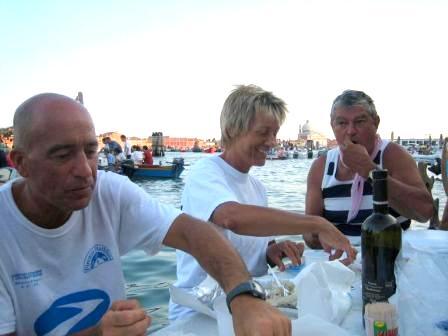
people. We hear the feet of all the people in the other Venices tromping around over our heads.
But look at it this way. Everybody here, including me, is here on purpose. Living in Venice isn’t for everyone, no matter how alluring their fantasies might be. It’s more like a vocation. Because we could all be somewhere else, at least theoretically. So while it’s possible to criticize Venice without loving her, it’s impossible to love her without criticizing, at least sometimes.
So I dedicate this blog to the fascination of Venice as a city, a place to live and which deserves to be loved for being — and not merely for having been — much more than the simple stuff of a million snapshots.